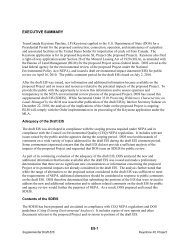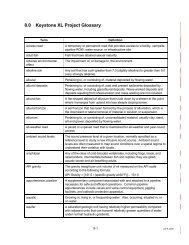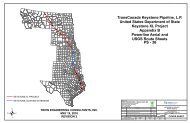2.1 Overview of the Proposed Project - Keystone XL pipeline - US ...
2.1 Overview of the Proposed Project - Keystone XL pipeline - US ...
2.1 Overview of the Proposed Project - Keystone XL pipeline - US ...
Create successful ePaper yourself
Turn your PDF publications into a flip-book with our unique Google optimized e-Paper software.
Draft Supplemental Environmental Impact Statement<strong>Keystone</strong> <strong>XL</strong> <strong>Project</strong>detect leaks down to approximately 5 percent <strong>of</strong> <strong>pipeline</strong> flow rate. Computational PipelineMonitoring or model-based leak detection systems would separate <strong>the</strong> <strong>pipeline</strong> system intosmaller segments and would monitor each segment on a mass balance basis. These systemswould detect leaks down to a level <strong>of</strong> approximately 1.5 to 2 percent <strong>of</strong> <strong>the</strong> <strong>pipeline</strong> flow rate.Computer-based, non-real time, accumulated gain/loss volume trending would assist inidentifying low rate or seepage leaks below <strong>the</strong> 1.5 to 2 percent by volume detection thresholds.If any <strong>of</strong> <strong>the</strong> s<strong>of</strong>tware-based leak detection methods indicates that a predetermined loss thresholdhas been exceeded, an alarm would be sent through SCADA and <strong>the</strong> Controller would takecorrective action. The SCADA system would continuously poll all data on <strong>the</strong> <strong>pipeline</strong> at aninterval <strong>of</strong> approximately 5 seconds.If an accidental leak were to occur, <strong>the</strong> operator would shut down operating pumping units andclose <strong>the</strong> isolation valves. Once shutdown activities are initiated, it would take approximately 9minutes to complete <strong>the</strong> emergency shut-down procedure (shut down operating pumping units)and an additional 3 minutes to close <strong>the</strong> isolation valves.In addition to <strong>the</strong> SCADA and complementary leak detection systems, direct observationmethods, including aerial patrols, ground patrols and public and landowner awareness programs,would be implemented to encourage and facilitate <strong>the</strong> reporting <strong>of</strong> suspected leaks and eventsthat could suggest a threat to <strong>the</strong> integrity <strong>of</strong> <strong>the</strong> <strong>pipeline</strong>.<strong>Keystone</strong> has committed to keep abreast <strong>of</strong> <strong>the</strong> latest developments in external leak detectiontechnologies (above and beyond those already proposed to be implemented, as described) thatcould be installed along <strong>the</strong> <strong>pipeline</strong> at sensitive locations. In Nebraska, <strong>Keystone</strong> would reportto, and discuss with, <strong>the</strong> Nebraska Department <strong>of</strong> Environmental Quality (NDEQ) <strong>the</strong> status <strong>of</strong>innovation in such <strong>pipeline</strong> leak detection equipment and <strong>the</strong> methods on or before January 1,2014, and at such additional times <strong>the</strong>reafter until 2024 as <strong>the</strong> NDEQ shall specifically request,but in no case more frequently than once every three years. A similar leak detection requirementexists in <strong>the</strong> SDPUC certificate. There is no comparable requirement in Montana.Emergency Response ProceduresPHMSA requires that <strong>pipeline</strong> operators prepare and abide by both <strong>the</strong> PSRP and <strong>the</strong> ERP forresponding to emergencies on <strong>the</strong>ir systems. 49 CFR 194 requires that <strong>pipeline</strong> operators haveresponse plans that ensure resources are available to remove, mitigate, or prevent a dischargefrom an oil <strong>pipeline</strong> that could cause substantial or significant harm to <strong>the</strong> environment,including a worst case discharge. As stated in 49 CFR 194.7(a), a <strong>pipeline</strong> operator “may nothandle, store, or transport oil unless <strong>the</strong> operator has submitted a response plan meetingrequirements <strong>of</strong> this part,” and as stated in 49 CFR 194.7(b), operators must also operate onshore<strong>pipeline</strong> facilities in accordance with <strong>the</strong> approved response plan. In addition, 49 CFR 194.107requires that <strong>the</strong> response plan include “procedures and a list <strong>of</strong> resources for responding, to <strong>the</strong>maximum extent practicable, to a worst case discharge, and to a substantial threat <strong>of</strong> such adischarge.”<strong>Keystone</strong> would determine <strong>the</strong> optimal location <strong>of</strong> spill response equipment, taking into accountresponse times to sensitive areas and receptors. These spill response locations would be reflectedin <strong>the</strong> ERP that would be submitted to PHMSA for review and approval.<strong>Keystone</strong> would submit a PSRP to PHMSA prior to initiation <strong>of</strong> proposed <strong>Project</strong> operations inaccordance with <strong>the</strong> requirements <strong>of</strong> 49 CFR 194. The PSRP would describe how spills would be<strong>Project</strong> Description <strong>2.1</strong>-68 March 2013











